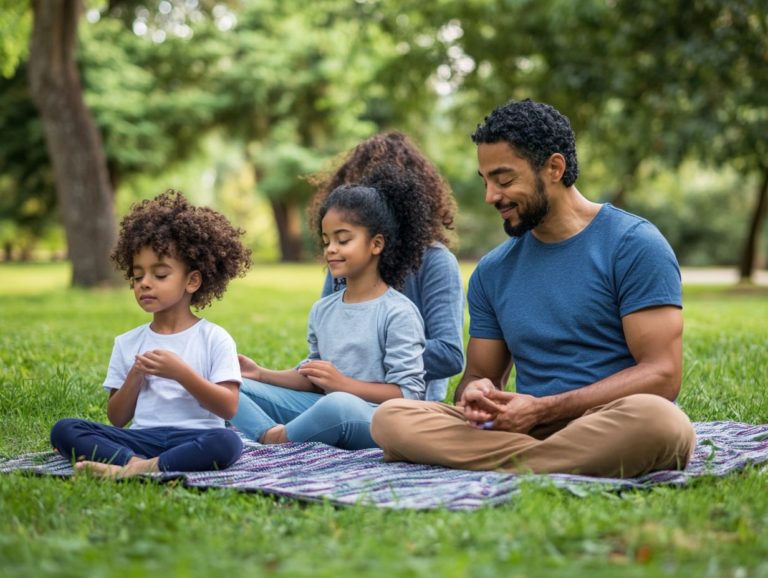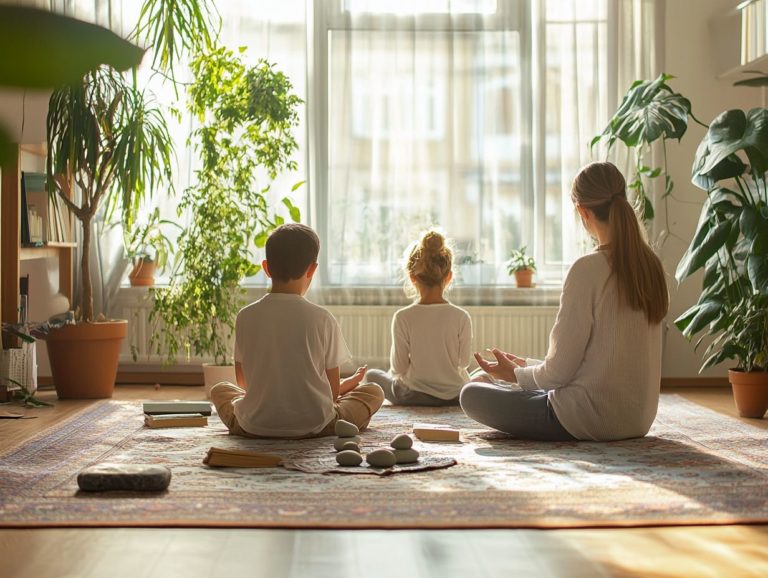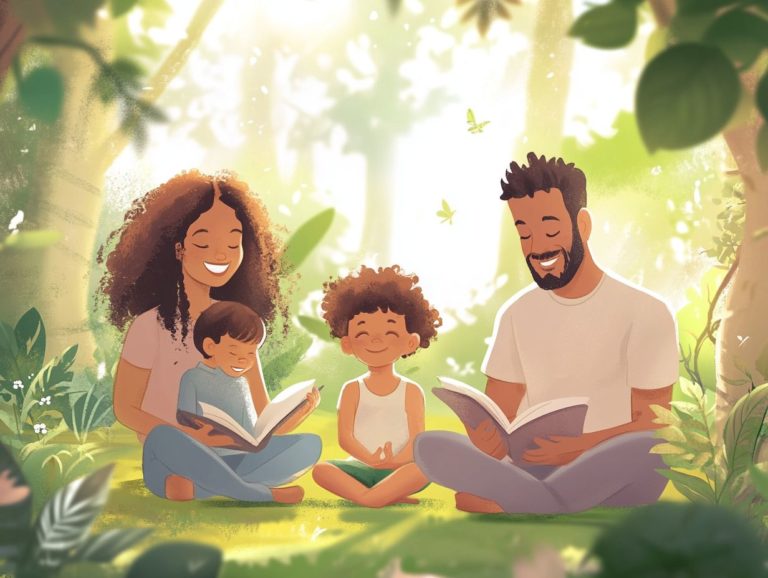Creative Mindfulness Activities for Kids
In today’s fast-paced world, teaching kids mindfulness and meditation is essential for nurturing their mental health and emotional well-being.
This article delves into a variety of creative mindfulness activities specifically crafted for children, ranging from mindful coloring and sensory walks to guided meditation and yoga. Each activity not only fosters focus and relaxation but also encourages gratitude, self-compassion, and awareness.
Discover key insights into overcoming everyday challenges and practical tips for seamlessly weaving mindfulness into daily routines, ensuring that kids can thrive amidst life’s hustle and bustle. These practices also support emotional regulation and mental well-being.
Dive in to uncover fun and enriching ways to introduce mindfulness to the young ones in your life! From mindfulness games to family activities, there’s something for everyone.
Contents
- Key Takeaways:
- 1. Mindful Coloring
- 2. Sensory Walk
- 3. Gratitude Journaling
- 4. Mindful Breathing Exercises
- 5. Mindful Listening Activities
- 6. Yoga for Kids
- 7. Nature Scavenger Hunt
- 8. Mindful Eating
- 9. Guided Meditation for Kids
- 10. Mindful Movement Games
- What Is Mindfulness and How Can It Benefit Kids?
- How Can Mindfulness Be Incorporated into Daily Routines?
- What Are Some Common Challenges When Practicing Mindfulness with Kids?
- What Are Some Age-Appropriate Mindfulness Activities for Different Age Groups?
- Frequently Asked Questions
- Creative Mindfulness Activities for Kids
- What are some examples of creative mindfulness activities for kids?
- How can creative mindfulness activities benefit children?
- Are there any specific age groups that these activities are suitable for?
- Can these activities be done alone or in a group setting?
- How can I incorporate creative mindfulness activities into my child’s daily routine?
- Are there any other benefits to practicing creative mindfulness activities for kids?
Key Takeaways:
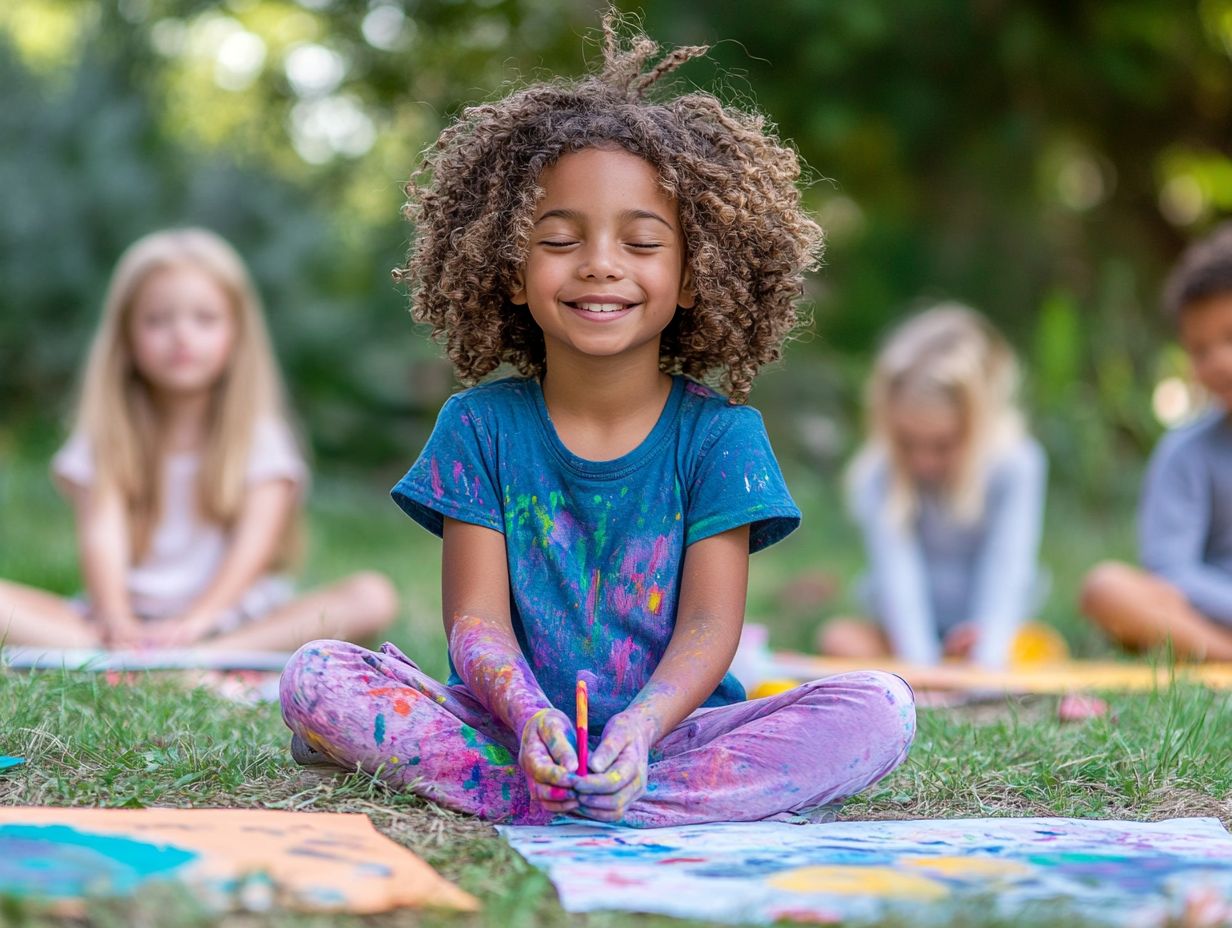
- Mindfulness can help improve children’s mental health and overall well-being.
- Simple mindfulness activities like coloring, breathing exercises, and yoga can be easily incorporated into daily routines, offering essential tools for stress management and emotional regulation.
- It’s important to introduce mindfulness in a fun and engaging way and tailor activities to the child’s age and abilities, enhancing their resilience and overall well-being.
1. Mindful Coloring
Mindful coloring is an engaging mindfulness activity that invites you to encourage kids to focus on the present moment while expressing their creativity.
This practice not only enhances their attention skills but also serves as a powerful tool for stress management, creating a serene environment for children to explore their feelings and thoughts in a creative way.
By incorporating mindful coloring into their routines, children can develop a sense of calm. This empowers them to better manage their emotions when faced with challenges.
You can further enrich this experience by introducing specific breathing techniques, like deep inhalation followed by a slow exhalation, which help center their focus and alleviate anxiety.
As children engage in this creative process, they can visually process their emotions, turning stress into a vibrant expression of their innermost thoughts. Setting aside time for mindful coloring sessions fosters self-discipline and cultivates a habit of reflection, supporting their overall mental well-being and self-compassion.
2. Sensory Walk
A sensory walk invites you to engage with your surroundings mindfully, enhancing your emotional awareness and appreciation for the present moment through a variety of sensory experiences.
This outdoor mindfulness activity encourages you to notice the sights, sounds, and smells around you, promoting a sense of well-being and a deeper connection with nature.
To structure these sensory walks effectively, incorporate mindfulness techniques that help you notice your body. Each step becomes an opportunity for exploration, filled with delightful surprises like discovering different textures underfoot or feeling the varying temperatures of the air.
Openly communicating about these experiences helps you develop essential communication skills and emotional intelligence, as you learn to express your observations and feelings.
By responding playfully to your discoveries, the adults in your life can cultivate a joyful atmosphere that enhances your exploration, fostering deeper connections between you and your environment.
3. Gratitude Journaling
Benefits of Gratitude Journaling
Gratitude journaling is an invaluable mindfulness practice for you and your children. It fosters emotional intelligence and enhances overall well-being by encouraging reflection on the positive moments in life.
By regularly jotting down what they are grateful for, kids can cultivate self-compassion and resilience both crucial traits for navigating life’s challenges. This practice is a key element of mindfulness meditation.
This practice nurtures positive thinking and aids in managing feelings, empowering children to better understand and manage their emotions while developing a healthier mindset.
Make it a fun family tradition! Each week, everyone can share their gratitude moments, creating a joyful atmosphere of openness and connection.
To enhance this experience, consider utilizing various mindfulness apps, which are apps that help you and your children practice being present and aware, like ‘Grateful‘ or ‘Calm.’ These apps offer guided journaling prompts and visualizations that engage children, turning the process into an enjoyable adventure.
Additionally, you can explore books designed around gratitude, providing tips and relatable examples for young minds.
4. Mindful Breathing Exercises
Mindful breathing exercises are invaluable mindfulness practices for you and your children. They provide essential tools to help them develop coping strategies for managing stress and anxiety while enhancing their attention and focus.
Through simple breathing techniques, kids can learn to regulate their emotions, cultivate self-awareness, and foster a sense of calm in their daily lives. Engaging in these exercises can improve academic performance and overall well-being.
These activities create a safe space for children to navigate their feelings, especially during overwhelming moments. By engaging in mindful breathing, they can learn to pause, observe their inner thoughts without judgment, and find clarity amidst the chaos.
Implementing techniques such as deep breathing, where they inhale deeply through their noses and exhale slowly through their mouths, simulates a calming wave that washes over them. Balloon breathing encourages kids to visualize inflating a balloon with each breath, reinforcing the idea of filling up with positivity.
Counting breaths can transform into a delightful game, making the practice enjoyable for them. Start incorporating these breathing exercises today! They not only improve emotional regulation but also promote resilience and a sense of calm.
5. Mindful Listening Activities
Engaging in mindful listening activities can significantly enhance your child’s mindfulness by nurturing their attention skills while simultaneously elevating their emotional awareness and empathy for others. These activities encourage them to immerse themselves in sounds and conversations be it the soothing whispers of nature or captivating storytelling resulting in deeper connections and strengthened communication abilities. These activities also help manage attention problems.
Incorporating experiences such as listening to calming music, the gentle rustle of leaves, or guided stories can truly enrich their journey. For example, you might invite them to close their eyes and focus on the subtle variations in music, encouraging them to observe how different instruments evoke a range of emotions.
Creating a tranquil and supportive environment is essential; it cultivates patience and kindness, allowing your child to be fully present without distractions. By sharing this mindful listening experience with others who are also engaged in the practice, they can deepen their understanding of empathy and respect, ultimately fostering more meaningful interactions with their peers. This is an essential aspect of mindfulness education.
6. Yoga for Kids

Yoga for kids seamlessly weaves mindfulness into physical activity, promoting not just body awareness but also managing feelings, resilience, and focus. Through gentle movements and mindful postures, you encourage children to connect with their bodies, develop strength, and cultivate a profound sense of calm and well-being. Family mindfulness sessions can further enhance these benefits.
Incorporating specific poses like Tree Pose or Puppy Pose adds an element of fun while encouraging balance and flexibility. As they master these poses, they enhance their physical abilities, strengthen their concentration, and relieve stress in a delightful way.
Weaving yoga into daily routines can have a remarkable impact. Practicing simple stretches in the morning or enjoying a brief session before bedtime can establish a sense of peace that prepares them for the day ahead. Integrating mindful breathing techniques during these sessions gives the power to children to manage their emotions effectively, transforming moments of anxiety into opportunities for tranquility.
7. Nature Scavenger Hunt
A nature scavenger hunt is an exciting adventure that sparks curiosity and connection with our beautiful environment! This playful endeavor encourages you to practice mindfulness by observing your surroundings, fostering a greater awareness and appreciation for the natural world while enhancing emotional regulation and resilience.
To get started, gather a group of kids and create a list of natural items for them to find think colorful leaves, unique rocks, or specific types of flowers. Encourage them to utilize their senses by asking questions about the textures, scents, and sounds they encounter along the way. Introducing gratitude practices can be seamlessly woven into the experience; after discovering an item, they can pause to express appreciation, perhaps sharing why it resonates with them or what it symbolizes.
This nurturing approach not only enriches their scavenger hunt experience but also cultivates a deeper respect for the environment, ultimately instilling a sense of stewardship toward nature that will last a lifetime. Let’s embark on this adventure today!
8. Mindful Eating
Mindful eating is a profound mindfulness practice that encourages kids to connect with their food and appreciate each bite. This practice promotes managing emotions, enhances attention, and fosters a deeper sense of gratitude and self-compassion. Encouraging kids to eat slowly and savor their food can transform meals into calming and reflective experiences. Mindful eating can be incorporated into family activities, creating opportunities for shared mindfulness moments.
Mindful eating invites children to truly engage with their food and enhances their overall well-being. By encouraging them to appreciate the sensory experiences associated with eating, you help them recognize their hunger cues, develop healthy eating habits, and cultivate a positive relationship with food. This practice also supports their overall mental health and emotional well-being.
Involving your kids in the cooking process can significantly enhance their mindfulness around meals. Encourage them to describe the colors, textures, and aromas of various ingredients. This not only keeps their interest piqued but also nurtures a deeper appreciation for what they put into their bodies. This can be a fun and engaging part of your family activities.
Implementing mealtime rituals, such as expressing gratitude for the food or sharing favorite dishes, can elevate the dining experience to new heights. These rituals serve as excellent gratitude practices for your family.
Try introducing a fun ‘mindful eating challenge’ for the whole family! Here, everyone takes a bite, pauses for a moment, and then describes how the food feels. This simple exercise reinforces awareness and strengthens the connection among family members during meals. It can also be a fun way to incorporate sensory experiences into your routine.
9. Guided Meditation for Kids
Guided meditation for kids serves as a remarkable resource, introducing mindfulness practices that empower children to cultivate emotional regulation and self-compassion through soothing narratives and imagery. These sessions enhance their well-being and attention skills while providing a structured approach for youngsters to learn essential mindfulness techniques. They also help manage stress and anxiety.
You ll discover a variety of guided meditations tailored specifically for young audiences, including focused audio narratives and interactive mindfulness apps that engage children through captivating stories and games. Resources like Calm, Headspace, and Smiling Mind offer customized content that caters to different age groups, making it easier for children to embrace these beneficial practices.
To successfully introduce guided meditation, create a tranquil environment, establish a regular practice schedule, and participate alongside your child. This fosters a sense of connection and interest. Discussing emotional experiences and encouraging expression during and after the sessions can significantly enhance the overall effectiveness of these mindfulness practices. This approach can also boost their resilience and self-esteem.
10. Mindful Movement Games
Mindful movement games seamlessly blend play with mindfulness practices, encouraging your children to develop attention training and body awareness through engaging and interactive activities. These games promote physical awareness and nurture emotional regulation, resilience, and self-esteem in your little ones. Activities can include mindfulness games and playful exercises.
By weaving simple, structured activities into your family playtime, you can significantly enhance your children’s ability to focus and manage their emotions. For instance, games like ‘Animal Yoga’ or ‘Mindful Nature Walks’ can easily be adjusted for various age levels young ones can mimic animals through playful movements, while older siblings or parents can introduce breathing techniques to elevate the experience.
Adding music or storytelling can further enrich these moments, transforming them into enjoyable and meaningful activities. These mindful movement games create an opportunity for your family to connect while cultivating healthy coping mechanisms and social skills critical for emotional well-being. Incorporating kindness wishes during these activities can also be beneficial.
Start today and watch how mindfulness transforms your family’s mealtime or playtime!
What Is Mindfulness and How Can It Benefit Kids?
Mindfulness is all about being fully present in the moment. It brings a wealth of benefits for children. You’ll notice improvements in their emotional regulation, a boost in self-compassion, and an overall sense of well-being. This can also enhance their attention and executive functions, which are skills that help children plan, focus, and control their actions.
By helping them learn to focus their attention and manage their thoughts and feelings, you’re equipping them with vital skills. These skills positively influence their mental health and resilience when facing challenges. This can also lead to improvements in their academic performance.
Cultivating mindfulness in kids can be achieved through straightforward techniques like mindful breathing, guided imagery, and visualization exercises. These practices not only encourage self-awareness but also nurture emotional intelligence, allowing children to better understand their emotions and empathize with others. Engaging in kindness meditation, which involves focusing on sending good wishes to ourselves and others, is an exciting practice that can transform their understanding of emotions!
Research has demonstrated that students who participate in mindfulness programs experience reduced levels of stress and anxiety. They also develop a more adaptable mindset when confronted with difficulties. A noteworthy study published in the journal ‘Psychological Science’ reveals that mindfulness training can lead to significant improvements in emotional regulation and coping strategies. This arms young individuals with lifelong tools for effectively managing stress. These findings underline the importance of mindfulness education in schools.
How Can Mindfulness Help with Children’s Mental Health?
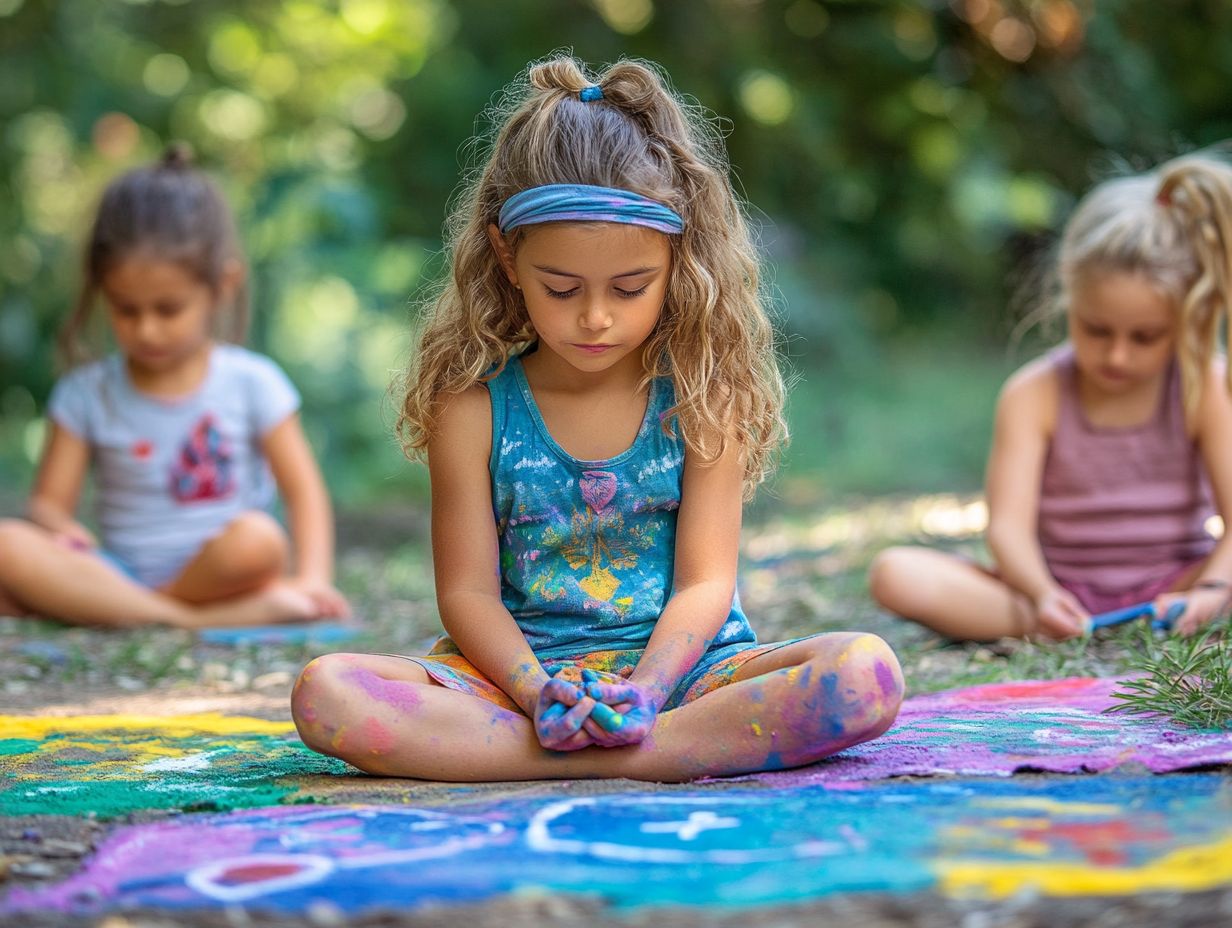
Mindfulness is essential for supporting your child’s mental health. It provides them with valuable tools for emotional regulation and effective stress management. When children engage in mindfulness practices, they learn to navigate anxiety, enhance their focus, and foster a more positive mindset. This journey ultimately leads to greater emotional intelligence and resilience. Engaging in mindfulness meditation regularly can be particularly beneficial.
The advantages of weaving mindfulness into daily routines cannot be overstated. For example, simple techniques like deep breathing exercises can significantly reduce stress and anxiety. These techniques help children feel more anchored during challenging moments. Mindful activities such as yoga or guided meditation not only sharpen attention skills but also cultivate a sense of calm amid the daily hustle and bustle. This can also enhance their communication skills.
As a parent, you can encourage these practices by setting aside quiet time for meditation or taking mindful walks together. This approach helps your child build self-esteem and develop a deeper awareness of their emotions. You can also engage them in conversations about their feelings to further reinforce these skills, creating a nurturing environment that supports their mental well-being. Involving other family activities can make this practice even more enriching.
What Are Some Tips for Introducing Mindfulness to Kids?
Introducing mindfulness to children can be a deeply rewarding journey. It s crucial to begin with age-appropriate practices that align with their interests and developmental stages. By fostering a supportive environment and incorporating engaging activities, you can help your children cultivate self-compassion, emotional awareness, and an appreciation for the present moment. Utilizing mindfulness apps can provide additional support in this journey.
- Start with simple mindfulness exercises that are enjoyable for them consider taking deep breaths together or observing the wonders of nature during a walk.
- Explore mindfulness apps specifically designed for children. They offer interactive and guided sessions that capture their interest.
- Weave mindfulness into your daily routines to create lasting habits; for example, practice gratitude journaling at dinner or dedicate a few minutes each day to mindful breathing.
- Including kindness meditation can also foster a deeper sense of connection.
By integrating these strategies into your family life, you can nurture a sense of calm and resilience in your children. This equips them to face life’s challenges with confidence. It can also improve their emotional intelligence and compassion.
Start incorporating mindfulness into your children’s lives today! This simple practice is a great way to support their mental health and overall well-being.
In summary, mindfulness offers invaluable tools to help children manage their emotions, enhance their focus, and build resilience. By introducing them to these practices, you empower them to navigate life’s ups and downs with confidence and compassion.
How Can Mindfulness Be Incorporated into Daily Routines?
Incorporating mindfulness into your daily routines can significantly enhance your children’s emotional regulation and overall well-being. It empowers them to embrace the present moment in their everyday lives. Simple mindfulness activities, such as mindful eating, breathing exercises, or gratitude practices, can be seamlessly woven into your routines. This creates valuable opportunities for reflection and connection.
To deepen this practice, consider setting aside specific times each week for mindfulness. Ideas include family meditation sessions or nature walks, where everyone can engage with their surroundings in a mindful state. Transforming everyday chores into mindfulness moments is also effective. For example, tune into the sensations while washing the dishes or the sounds of nature while gardening. This can nurture a sense of presence and enhance family mindfulness experiences.
Family game nights focused on mindfulness can also foster a collective mindfulness experience. Participants can share positive affirmations or tell stories. This not only reinforces emotional bonds but also enhances emotional intelligence among family members. You can include mindfulness resources in these activities for added benefits.
What Are Some Common Challenges When Practicing Mindfulness with Kids?
Practicing mindfulness with children can pose several challenges, including attention issues, resistance to new practices, and a limited understanding of what mindfulness really means. By acknowledging these hurdles and implementing supportive techniques, you can effectively guide your children in developing emotional awareness and coping strategies. This will enhance their overall well-being.
To successfully navigate these challenges, it s crucial to foster an atmosphere of patience and consistency. Engage your children in playful and creative activities that transform mindfulness from a chore into an enjoyable part of their daily lives. Utilizing mindfulness education techniques can also be very helpful.
For example, you can turn breathing techniques into fun mindfulness games or weave mindfulness into creative arts. This greatly boosts their participation and interest. You might also consider creative mindfulness activities for kids to further engage them. Setting aside specific times for practice like during family activities or at bedtime will help establish a routine. This makes mindfulness a familiar aspect of their lives and enhances their emotional regulation.
Creating a supportive environment and being a role model yourself can profoundly inspire your children’s commitment to mindfulness practices. This includes mindfulness meditation and kindness meditation.
What Are Some Age-Appropriate Mindfulness Activities for Different Age Groups?
Finding age-appropriate mindfulness activities is crucial for effectively engaging kids. Each age group responds uniquely to different mindfulness practices. By customizing activities to align with their developmental stages, you can help children cultivate emotional regulation, self-awareness, and a deeper understanding of mindfulness concepts.
This personalized approach makes mindfulness not just effective but an exciting journey! For preschoolers, simple breathing techniques and sensory exploration are invaluable as they learn to recognize their feelings and calm their busy minds.
- Elementary school children can thrive with guided visualization techniques or mindful storytelling, both of which promote empathy and concentration.
- As teenagers navigate the complexities of growing up, practices like journaling, meditation, and yoga can be instrumental in supporting stress relief, self-reflection, and resilience.
These activities nurture emotional intelligence and resilience, equipping them with essential skills for managing life’s challenges and improving their well-being.
Frequently Asked Questions
Creative Mindfulness Activities for Kids
What are some examples of creative mindfulness activities for kids?
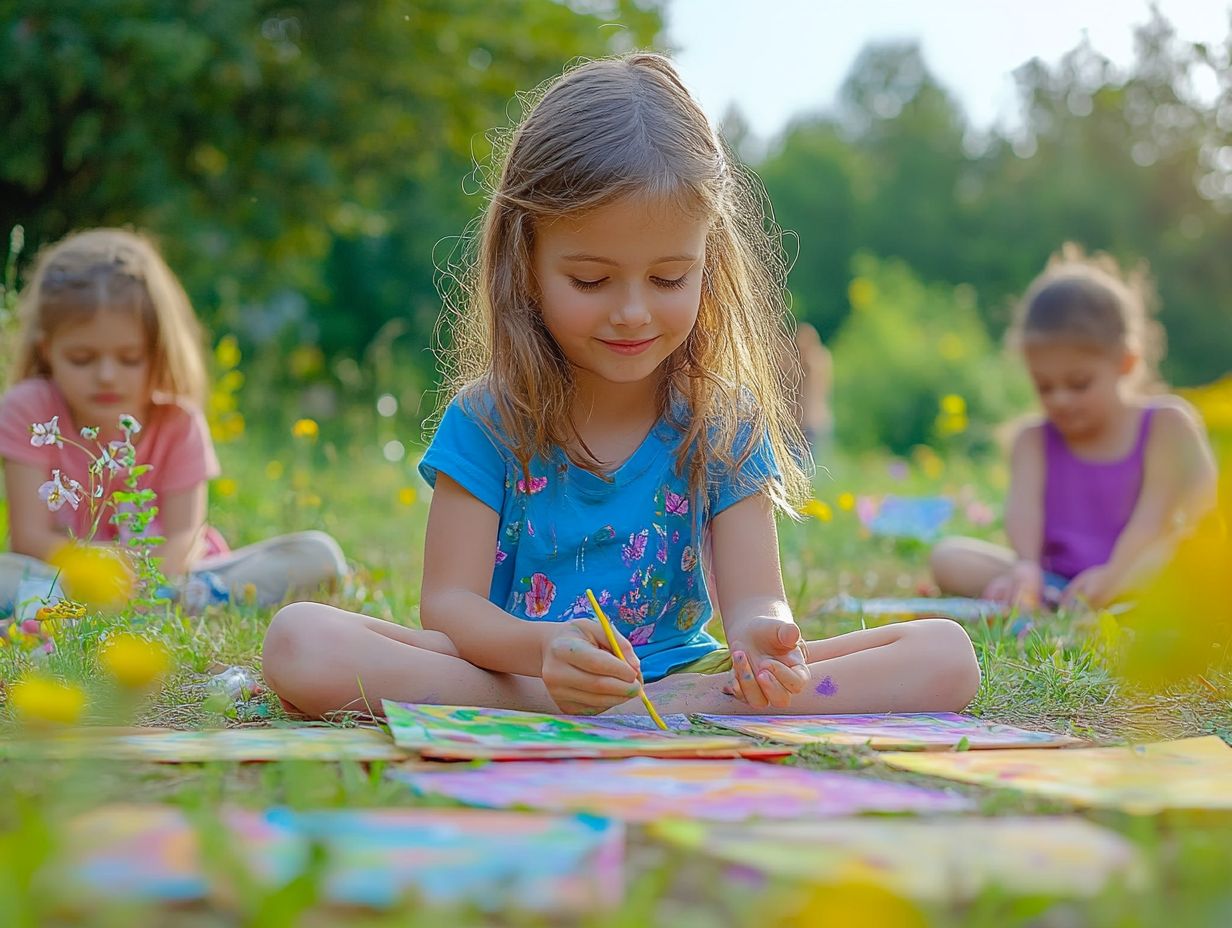
Some examples include mindful coloring, creating a gratitude journal, making a sensory bottle, or practicing yoga and meditation.
How can creative mindfulness activities benefit children?
These activities help children build self-awareness and improve focus and attention.
They also reduce stress and anxiety, fostering creativity and imagination.
Are there any specific age groups that these activities are suitable for?
These activities can be adapted for children of all ages.
However, they work well for older kids who understand their feelings better.
Can these activities be done alone or in a group setting?
Both options are possible! Some children may prefer to do these activities alone for a more personal experience.
Others may enjoy doing them with friends or family for a sense of connection and support.
How can I incorporate creative mindfulness activities into my child’s daily routine?
Set aside a fun time each day for these exciting activities, like during quiet time or before bedtime!
You can encourage your child to incorporate mindfulness into their daily activities, such as mindful breathing while playing or walking.
Using mindfulness apps can also be an excellent addition to their routine. Make it a daily adventure!
Are there any other benefits to practicing creative mindfulness activities for kids?
Yes! These activities also help kids manage their emotions better.
They enhance problem-solving skills and promote a more positive and compassionate outlook on life.
This contributes to better mental health and well-being.
Start your mindfulness journey today and watch your child thrive!


